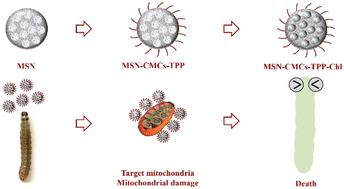当前位置:
X-MOL 学术
›
Environ. Sci.: Nano
›
论文详情
Our official English website, www.x-mol.net, welcomes your feedback! (Note: you will need to create a separate account there.)
Mitochondria-targeted nanocarriers doubled the toxicity of oxidative phosphorylation and ATP synthesis disruptive insecticides against Spodoptera frugiperda
Environmental Science: Nano ( IF 7.3 ) Pub Date : 2022-09-05 , DOI: 10.1039/d2en00502f Youwu Hao 1 , Di Liu 1 , Yonghui Song 1 , Xinming Yin 1 , Jia Liu 1 , Risong Na 1 , Qing X. Li 2
Environmental Science: Nano ( IF 7.3 ) Pub Date : 2022-09-05 , DOI: 10.1039/d2en00502f Youwu Hao 1 , Di Liu 1 , Yonghui Song 1 , Xinming Yin 1 , Jia Liu 1 , Risong Na 1 , Qing X. Li 2
Affiliation

|
Translocation and delivery of pesticides onto the molecular target is often a limiting step of efficacy, causing excessive use of pesticides and adverse effects on the environment and human health. Advances of nanomaterials have opened up a new avenue for effective translocation and delivery to increase the pesticide efficacy and reduce risks. We successfully synthesized and fully characterized a mesoporous silica nanoparticle-based mitochondria-targeted pesticide nanocarrier for the oxidative phosphorylation and ATP synthesis disruptor chlorfenapyr (Chl). The nanocarriers can be readily absorbed orally and translocated into the midgut and Malpighian duct of Spodoptera frugiperda larvae and target mitochondria at the subcellular level. The Chl loading content on the nanocarrier was up to 35%. The toxicity of the Chl nanocarriers to the 3rd instar S. frugiperda larvae (half-maximum lethal concentration (LC50), 16.4 μg g−1 expressed by the Chl content) was almost doubled relative to Chl alone (LC50 = 30.1 μg g−1). Further research showed that the mitochondria-targeted nanocarrier enhanced Chl efficacy by inducing mitochondrial damage in Sf9 cells, which led to the collapse of the mitochondrial membrane potential and reduction of ATP production. The mitochondria-targeted nanocarriers have great application potential in the formulation of oxidative phosphorylation and ATP synthesis disruptors, which can minimize their potential threats to food/environmental safety.
中文翻译:

线粒体靶向纳米载体使氧化磷酸化和 ATP 合成破坏性杀虫剂对草地夜蛾的毒性加倍
将杀虫剂转移和递送到分子靶标上通常是药效的限制步骤,导致过度使用杀虫剂并对环境和人类健康产生不利影响。纳米材料的进步为有效转运和递送以提高农药效力和降低风险开辟了一条新途径。我们成功地合成并充分表征了一种基于介孔二氧化硅纳米颗粒的线粒体靶向农药纳米载体,用于氧化磷酸化和 ATP 合成破坏剂氯芬吡 (Chl)。纳米载体可以很容易地被口服吸收并转移到草地贪夜蛾的中肠和马氏管中幼虫在亚细胞水平上靶向线粒体。纳米载体上的叶绿素负载量高达 35%。Chl 纳米载体对第 3 龄S. frugiperda幼虫的毒性(半数致死浓度(LC 50),16.4 μg g -1由 Chl 含量表示)相对于单独的 Chl(LC 50 = 30.1 μg g -1)。进一步的研究表明,靶向线粒体的纳米载体通过诱导 Sf9 细胞中的线粒体损伤来增强 Chl 的功效,从而导致线粒体膜电位的崩溃和 ATP 产生的减少。线粒体靶向纳米载体在制备氧化磷酸化和 ATP 合成破坏剂方面具有巨大的应用潜力,可以最大限度地减少其对食品/环境安全的潜在威胁。
更新日期:2022-09-05
中文翻译:

线粒体靶向纳米载体使氧化磷酸化和 ATP 合成破坏性杀虫剂对草地夜蛾的毒性加倍
将杀虫剂转移和递送到分子靶标上通常是药效的限制步骤,导致过度使用杀虫剂并对环境和人类健康产生不利影响。纳米材料的进步为有效转运和递送以提高农药效力和降低风险开辟了一条新途径。我们成功地合成并充分表征了一种基于介孔二氧化硅纳米颗粒的线粒体靶向农药纳米载体,用于氧化磷酸化和 ATP 合成破坏剂氯芬吡 (Chl)。纳米载体可以很容易地被口服吸收并转移到草地贪夜蛾的中肠和马氏管中幼虫在亚细胞水平上靶向线粒体。纳米载体上的叶绿素负载量高达 35%。Chl 纳米载体对第 3 龄S. frugiperda幼虫的毒性(半数致死浓度(LC 50),16.4 μg g -1由 Chl 含量表示)相对于单独的 Chl(LC 50 = 30.1 μg g -1)。进一步的研究表明,靶向线粒体的纳米载体通过诱导 Sf9 细胞中的线粒体损伤来增强 Chl 的功效,从而导致线粒体膜电位的崩溃和 ATP 产生的减少。线粒体靶向纳米载体在制备氧化磷酸化和 ATP 合成破坏剂方面具有巨大的应用潜力,可以最大限度地减少其对食品/环境安全的潜在威胁。



























 京公网安备 11010802027423号
京公网安备 11010802027423号